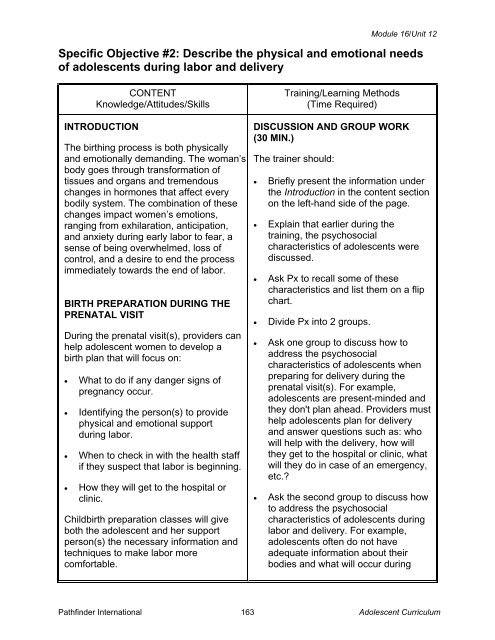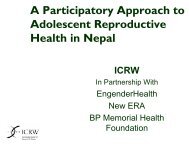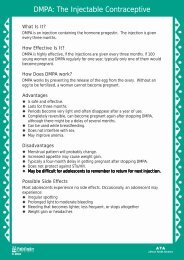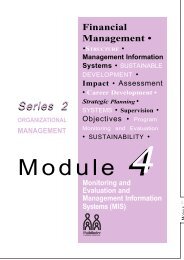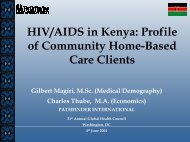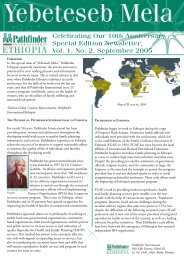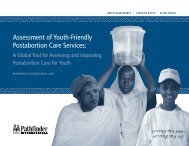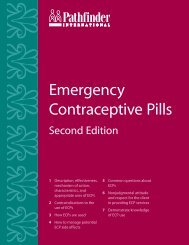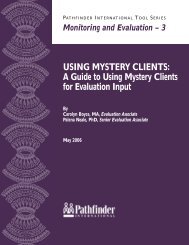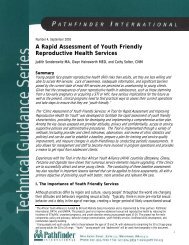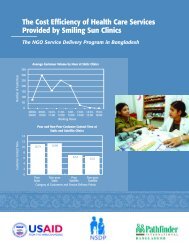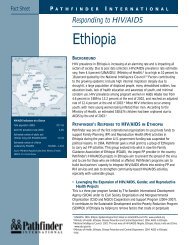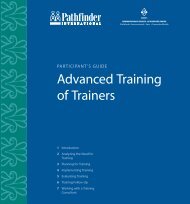reproductive health services for adolescents - Pathfinder International
reproductive health services for adolescents - Pathfinder International
reproductive health services for adolescents - Pathfinder International
You also want an ePaper? Increase the reach of your titles
YUMPU automatically turns print PDFs into web optimized ePapers that Google loves.
Module 16/Unit 12<br />
Specific Objective #2: Describe the physical and emotional needs<br />
of <strong>adolescents</strong> during labor and delivery<br />
CONTENT<br />
Knowledge/Attitudes/Skills<br />
INTRODUCTION<br />
The birthing process is both physically<br />
and emotionally demanding. The woman’s<br />
body goes through trans<strong>for</strong>mation of<br />
tissues and organs and tremendous<br />
changes in hormones that affect every<br />
bodily system. The combination of these<br />
changes impact women’s emotions,<br />
ranging from exhilaration, anticipation,<br />
and anxiety during early labor to fear, a<br />
sense of being overwhelmed, loss of<br />
control, and a desire to end the process<br />
immediately towards the end of labor.<br />
BIRTH PREPARATION DURING THE<br />
PRENATAL VISIT<br />
During the prenatal visit(s), providers can<br />
help adolescent women to develop a<br />
birth plan that will focus on:<br />
• What to do if any danger signs of<br />
pregnancy occur.<br />
• Identifying the person(s) to provide<br />
physical and emotional support<br />
during labor.<br />
• When to check in with the <strong>health</strong> staff<br />
if they suspect that labor is beginning.<br />
• How they will get to the hospital or<br />
clinic.<br />
Childbirth preparation classes will give<br />
both the adolescent and her support<br />
person(s) the necessary in<strong>for</strong>mation and<br />
techniques to make labor more<br />
com<strong>for</strong>table.<br />
Training/Learning Methods<br />
(Time Required)<br />
DISCUSSION AND GROUP WORK<br />
(30 MIN.)<br />
The trainer should:<br />
• Briefly present the in<strong>for</strong>mation under<br />
the Introduction in the content section<br />
on the left-hand side of the page.<br />
• Explain that earlier during the<br />
training, the psychosocial<br />
characteristics of <strong>adolescents</strong> were<br />
discussed.<br />
• Ask Px to recall some of these<br />
characteristics and list them on a flip<br />
chart.<br />
• Divide Px into 2 groups.<br />
• Ask one group to discuss how to<br />
address the psychosocial<br />
characteristics of <strong>adolescents</strong> when<br />
preparing <strong>for</strong> delivery during the<br />
prenatal visit(s). For example,<br />
<strong>adolescents</strong> are present-minded and<br />
they don't plan ahead. Providers must<br />
help <strong>adolescents</strong> plan <strong>for</strong> delivery<br />
and answer questions such as: who<br />
will help with the delivery, how will<br />
they get to the hospital or clinic, what<br />
will they do in case of an emergency,<br />
etc.<br />
• Ask the second group to discuss how<br />
to address the psychosocial<br />
characteristics of <strong>adolescents</strong> during<br />
labor and delivery. For example,<br />
<strong>adolescents</strong> often do not have<br />
adequate in<strong>for</strong>mation about their<br />
bodies and what will occur during<br />
<strong>Pathfinder</strong> <strong>International</strong><br />
163<br />
Adolescent Curriculum


